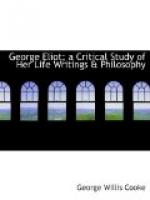“I seemed myself to live between heaven and earth. I was not in heaven because of my body, nor upon earth because of my soul. Earth was a scale to heaven, and all I tasted was God. I could pray without ceasing, and in everything give thanks. I felt that the secret of the Lord is with them that fear Him. If I wanted to know anything I had only to ask, and it was given, generally in a moment. Whether I was in the public street, or at my work, or in my private room, I had continued intercourse with my God; and many, I think I may say hundreds of times, He shone upon His Word, and showed me the meaning thereof, that is, texts of scripture, so as to furnish me with sufficient matter to speak to poor sinners for a sufficient length of time.”
The life of Elizabeth Evans was only a hint to the mind of the author of Adam Bede. Dinah was not intended as a portrait, and the resemblances between the two were probably not the result of a conscious purpose on the part of George Eliot. Soon after the publication of Adam Bede, when gossip had begun to report that Dinah Morris was an accurate sketch of Elizabeth Evans, and even that her sermon and prayers had been copied from the writings of the aunt, George Eliot wrote a letter to her intimate friend, Miss Sara Hennell, in which she explained to what extent she was indebted to Elizabeth Evans for the portrait of Dinah Morris.
HOLLY LODGE, Oct. 7, 1850.
Dear Sara,—I should like, while the subject is vividly present with me, to tell you more exactly than I have ever yet done, what I knew of my aunt, Elizabeth Evans. My father, you know, lived in Warwickshire all my life with him, having finally left Staffordshire first, and then Derbyshire, six or seven years before he married my mother.... [Footnote: What is here omitted of this letter will be found on page 12.]
As to my aunt’s conversation, it is a fact that the only two things of any interest I remember in our lonely sittings and walks are her telling me one sunny afternoon how she had, with another pious woman, visited an unhappy girl in prison, stayed with her all night, and gone with her to execution, and one or two accounts of supposed miracles in which she believed—among the rest, the face with the crown of thorns seen in the glass. In her account of the prison scenes. I remember no word she uttered—I only remember her tone and manner, and the deep feeling I had under the recital. Of the girl she knew nothing, I believe—or told me nothing—but that she was a common coarse girl, convicted of child-murder. The incident lay in my mind for years on years as a dead germ, apparently, till time had made my mind a nisus in which it could fructify; it then turned out to be the germ of Adam Bede.




